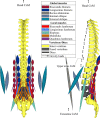Biomechanical effects of lumbar fusion surgery on adjacent segments using musculoskeletal models of the intact, degenerated and fused spine
- PMID: 34504207
- PMCID: PMC8429534
- DOI: 10.1038/s41598-021-97288-2
Biomechanical effects of lumbar fusion surgery on adjacent segments using musculoskeletal models of the intact, degenerated and fused spine
Abstract
Adjacent segment disorders are prevalent in patients following a spinal fusion surgery. Postoperative alterations in the adjacent segment biomechanics play a role in the etiology of these conditions. While experimental approaches fail to directly quantify spinal loads, previous modeling studies have numerous shortcomings when simulating the complex structures of the spine and the pre/postoperative mechanobiology of the patient. The biomechanical effects of the L4-L5 fusion surgery on muscle forces and adjacent segment kinetics (compression, shear, and moment) were investigated using a validated musculoskeletal model. The model was driven by in vivo kinematics for both preoperative (intact or severely degenerated L4-L5) and postoperative conditions while accounting for muscle atrophies. Results indicated marked changes in the kinetics of adjacent L3-L4 and L5-S1 segments (e.g., by up to 115% and 73% in shear loads and passive moments, respectively) that depended on the preoperative L4-L5 disc condition, postoperative lumbopelvic kinematics and, to a lesser extent, postoperative changes in the L4-L5 segmental lordosis and muscle injuries. Upper adjacent segment was more affected post-fusion than the lower one. While these findings identify risk factors for adjacent segment disorders, they indicate that surgical and postoperative rehabilitation interventions should focus on the preservation/restoration of patient's normal segmental kinematics.
© 2021. The Author(s).
Conflict of interest statement
The authors declare no competing interests.
Figures





Similar articles
-
Adjacent segments biomechanics following lumbar fusion surgery: a musculoskeletal finite element model study.Eur Spine J. 2022 Jul;31(7):1630-1639. doi: 10.1007/s00586-022-07262-3. Epub 2022 May 28. Eur Spine J. 2022. PMID: 35633382
-
Biomechanical Effect of L4 -L5 Intervertebral Disc Degeneration on the Lower Lumbar Spine: A Finite Element Study.Orthop Surg. 2020 Jun;12(3):917-930. doi: 10.1111/os.12703. Epub 2020 May 31. Orthop Surg. 2020. PMID: 32476282 Free PMC article.
-
Kinematic evaluation of one- and two-level Maverick lumbar total disc replacement caudal to a long thoracolumbar spinal fusion.Eur Spine J. 2012 Jun;21 Suppl 5(Suppl 5):S599-611. doi: 10.1007/s00586-012-2301-4. Epub 2012 Apr 25. Eur Spine J. 2012. PMID: 22531900 Free PMC article.
-
Risk factors for adjacent segment degeneration after PLIF.Spine (Phila Pa 1976). 2004 Jul 15;29(14):1535-40. doi: 10.1097/01.brs.0000131417.93637.9d. Spine (Phila Pa 1976). 2004. PMID: 15247575 Review.
-
Limitations of current in vitro test protocols for investigation of instrumented adjacent segment biomechanics: critical analysis of the literature.Eur Spine J. 2015 Sep;24(9):1882-92. doi: 10.1007/s00586-015-4040-9. Epub 2015 Jun 3. Eur Spine J. 2015. PMID: 26038156 Review.
Cited by
-
Regulating the fate of stem cells for regenerating the intervertebral disc degeneration.World J Stem Cells. 2021 Dec 26;13(12):1881-1904. doi: 10.4252/wjsc.v13.i12.1881. World J Stem Cells. 2021. PMID: 35069988 Free PMC article. Review.
-
Abdominal wall tension after spinal deformity correction compromises postoperative biomechanics and may contribute to proximal junctional kyphosis.Eur Spine J. 2025 Jun 26. doi: 10.1007/s00586-025-09063-w. Online ahead of print. Eur Spine J. 2025. PMID: 40562995
-
Thoracic Fracture Adjacent to Spinal Fusion Following Cardiopulmonary Resuscitation: A Case Report.Cureus. 2025 Jun 24;17(6):e86656. doi: 10.7759/cureus.86656. eCollection 2025 Jun. Cureus. 2025. PMID: 40709138 Free PMC article.
-
Factors associated with incomplete clinical improvement in patients undergoing transforaminal endoscopic lumbar discectomy for lumbar disc herniation.Eur Spine J. 2023 Aug;32(8):2700-2708. doi: 10.1007/s00586-023-07636-1. Epub 2023 Mar 14. Eur Spine J. 2023. PMID: 36917301
-
Is ABO blood type a risk factor for adjacent segment degeneration after lumbar spine fusion?Eur Spine J. 2025 Jan;34(1):170-181. doi: 10.1007/s00586-024-08516-y. Epub 2024 Oct 14. Eur Spine J. 2025. PMID: 39402430
References
-
- Charles Malveaux WMS, Sharan AD. Adjacent segment disease after lumbar spinal fusion: a systematic review of the current literature. Semin. Spine Surg. 2011;23:266–274. doi: 10.1053/j.semss.2011.05.008. - DOI
Publication types
MeSH terms
LinkOut - more resources
Full Text Sources

